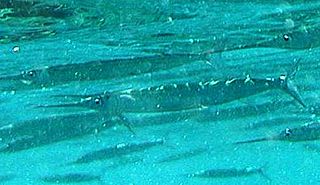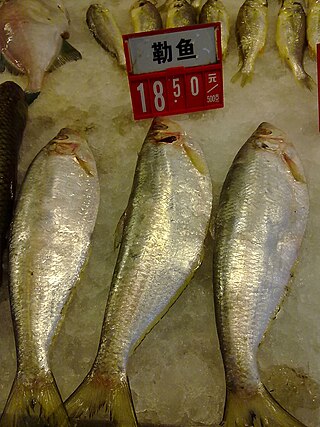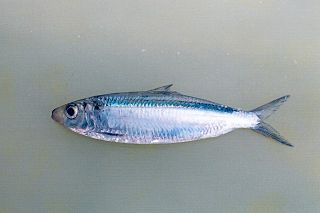
Clupeiformes is the order of ray-finned fish that includes the herring family, Clupeidae, and the anchovy family, Engraulidae. The group includes many of the most important forage and food fish.

Herring are various species of forage fish, mostly belonging to the family of Clupeidae.

Pristigasteridae is a family of ray-finned fish related to the herrings, including the genera Ilisha, Pellona, and Pristigaster. One common name for the taxon is longfin herring. The taxonomic classification of this family is in doubt; it was traditionally divided into two subfamilies, Pelloninae and Pristigasterinae, but molecular data indicates that these are not monophyletic.

Hemiramphus is a genus of schooling marine fish commonly called halfbeaks, garfish, or ballyhoos, and are members of the family Hemiramphidae. They inhabit the surface of warm temperate and tropical sea, and feed on algae, plankton, and smaller fish. Hemiramphus species are edible but are more important as food fish for larger predatory species including dolphinfish and billfish.

Sardinella is a genus of fish in the family Dorosomatidae found in the Atlantic, Indian and Pacific Ocean. They are abundant in warmer waters of the tropical and subtropical oceans. Adults are generally coastal, schooling, marine fish but juveniles are often found in lagoons and estuaries. These species are distinguished by their ranges and by specific body features, but they are often confused with one another. Fish of the genus have seven to 14 striped markings along the scales of the top of the head. The paddle-shaped supramaxilla bones are characteristic; they separate Sardinella from other genera and their shapes help distinguish species. They have paired predorsal scales and enlarged fin rays.

The longfin trevally, also known as the longfin kingfish, longfin cavalla or armed trevally, is a species of inshore marine fish in the jack family, Carangidae. The species is common in tropical to subtropical waters of the Indo-Pacific, ranging from South Africa in the west to Japan in the east, typically inhabiting inshore reefs and bays. The species is easily distinguished by its elongate dorsal and anal fin lobes and filamentous dorsal rays, as well as its scaleless breast. Longfin trevally are pelagic predators, taking a variety of small fish, cephalopods and crustaceans, and reach sexual maturity at around 21 cm. The species has a maximum known length of 57 cm and weight of 3.5 kg. The longfin trevally has a very complex taxonomic history which is closely intertwined with another currently valid species, Carangoides ciliarius, which may yet prove to be synonymous. Longfin trevally are of minor importance to fisheries throughout their range and are considered good table fish, and are occasionally taken by anglers.

Pellona is a genus of ray-finned fishes in the family Pristigasteridae. The genus contains six species. Three of these are restricted to freshwater habitats in tropical and subtropical South America, while P. dayi and P. ditchela are found in coastal waters of the Indo-Pacific, and P. harroweri is found in coastal Atlantic waters from Panama to Brazil.

Ilisha is a genus of ray-finned fishes in the family Pristigasteridae. The genus contains 16 species. It is similar to Pellona but lacks a toothed hypo-maxilla. The genus has a worldwide distribution in tropical and subtropical coastal waters and estuaries. Some species also enter rivers, and I. amazonica and I. novacula are largely–if not entirely–restricted to tropical rivers.

Anchoa is a genus of ray-finned fishes in the family Engraulidae. It currently consists of 35 species.

Pristigaster is a small genus of ray-finned fish belonging to the family Pristigasteridae. It contains two species, both restricted to the Amazon Basin in South America.
Odontognathus is a genus of longfin herrings in the family Pristigasteridae. Currently, three species are recognized for this genus, all of which are restricted to tropical waters of the Western Hemisphere.
Opisthopterus is a genus of longfin herring in the family Pristigasteridae. There are currently six species in this genus. They are found in Indo-Pacific.
Pliosteostoma is a monospecific genus of marine ray-finned fish belonging to the family Pristigasteridae, the longfin herrings. The only species in the genus is Pliosteostoma lutipinnis, the yellowfin herring, a species found along the Pacific coast of Central and South America between Mexico and Ecuador.

Raconda is a monospecific genus of marine ray-finned fish belonging to the family Pristigasteridae, the longfin herrings. The only species in the genus is Raconda russeliana, the raconda, a species found in the eastern Indian Ocean and far western Pacific Ocean.

The elongate ilisha, also known as the Chinese herring or slender shad, is a species of longfin herring native to the coastal waters and estuaries of North Indian Ocean and Northwest Pacific. It is a relatively large species, up to 45–60 centimetres (18–24 in) in total length. It is an important fishery species.

Xenichthys is a genus of grunts native to the eastern Pacific Ocean.

The Alosidae, or the shads, are a family of clupeiform fishes. The family currently comprises four genera worldwide, and about 32 species.

Amblygaster leiogaster, the smoothbelly sardinella, also known as blue sardine, blue sprat, bluebait, is a reef-associated marine species of sardinella in the herring family Clupeidae. It is one of the three species of genus Amblygaster. It is found in the marine waters along Indo-West Pacific regions south towards western Australia. The fish has 13 to 21 dorsal soft rays and 12 to 23 anal soft rays. It grows up to a maximum length of 23 cm. The flank is gold in fresh fish but becomes black while preservation. Belly is more rounded and scutes are not prominent. It is rather closely resemble Amblygaster clupeoides, but the latter has very few lower gill rakers than smoothbelly sardinella. The fish feeds on minute organisms like zooplankton.

Clupeoidei is a suborder of marine and freshwater ray-finned fishes belonging to the order Clupeiformes, an order which includes the herrings, anchovies and shads.












